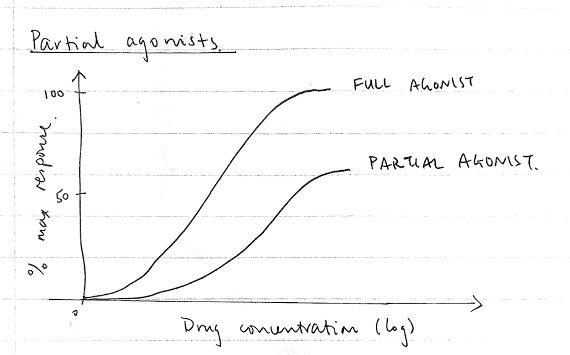22B19: Exam Report
What are receptors? (20% marks). Discuss the relationship between the properties of a drug and potential receptor response under the following headings: agonists, partial agonists, inverse agonists and antagonists (80% marks)
31% of candidates passed this question.
The description of a receptor was worth 20% thus it was expected that detailed information on the different forms of receptors, their structure, the resultant conformational change when activated and where they are found would be provided for full marks.
Most candidates were able to correctly define an agonist, antagonist, partial agonist and inverse agonist.
Unfortunately, this was the limit of most answers. Candidates were expected to provide details of drug or agonist/receptor interaction discussing the terms affinity/intrinsic activity and how different mechanisms of binding and interacting with the receptor alters these terms.
Cii / 22B19: What are receptors? (20% marks). Discuss the relationship between the properties of a drug and potential receptor response under the following headings: agonists, partial agonists, inverse agonists and antagonists (80% marks)
Receptors are protein molecules to which ligands bind in order to effect the regulation of a cellular process. In vivo, they function to recognise and respond to endogenous chemical signals.
4 Main Types of Receptors
Ligand Gated Ion Channels
GPCR
Kinase Linked
Nuclear Receptors
Structure
Ligand Gated Ion Channels
Oligomeric (often pentameric) assembly of subunits surrounding a central pore on cell membrane
GPCR
Serpentine proteins consisting of 7 transmembrane helices with intracellular G protein coupling domain
Kinase Linked
Large proteins consisting of a single membrane spanning helical region with a large extracellular ligand binding domain
Nuclear Receptors
Monometric structure with separate receptor and DNA binding domains
Effect after ligand binding
Ligand Gated Ion Channels
Opening of central pore → nerve hyperpolarisation OR depolarisation due to ionic flux
GPCR
Binding of ligand causes the receptor to activate the G protein (composed of α, β, γ subunits) which bind GDP.
Upon stimulation, GTP replaces GDP → α-GTP subunit dissociates to activate/inhibit an effector protein
Kinase Linked
Binding of ligand causes dimerisation leading to autophosphorylation of tyrosine residues on the intracellular domain → flow on signal transduction via intracellular protein kinases
Nuclear Receptors
Binding of ligand effects changes in gene transcription
Site
Ligand Gated Ion Channels
Membrane of nerves / muscles
GPCR
Cell membrane
Kinase Linked
Cell membrane
Nuclear Receptors
Intracellular
Example
Ligand Gated Ion Channels
Nicotinic ACh receptors, GABA-A, NMDA and AMPA receptors
GPCR
Muscarinic ACh receptors, adrenoreceptors
Kinase Linked
JAK kinases
Nuclear Receptors
Steroid hormone receptors
Agonists
Agonists are drugs that bind to physiological receptors to elicit the same response as the endogenous ligand
- A full agonist which drug which produces a maximal response at the receptor site. i.e. high affinity and an intrinsic activity of 1
- Affinity is how avidly a drug binds to its receptor. Described by the association constant, Ka
- Intrinsic activity (IA) is the ability of a bound agonist to cause a maximum response. Maximum IA is 1
- g. morphine at opioid receptors
Partial Agonist
A partial agonist is a drug which is unable to induce maximal activation of a receptor population, regardless of the amount of drug applied
- High affinity but intrinsic activity between 0 and 1
- g. buprenorphine at opioid receptors

Inverse Agonist
An inverse agonist is a drug that binds to the same receptor as an agonist but induces a pharmacological response opposite to that of the agonist
- This is due to the agonist being relatively more selective for the resting state of the receptor
High affinity but intrinsic activity between -1 and 0
Author: Andrew Wang